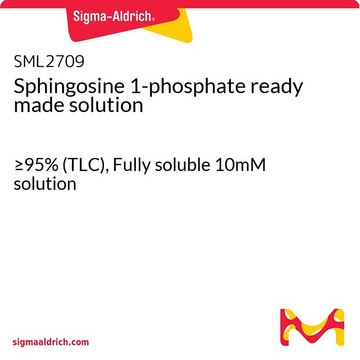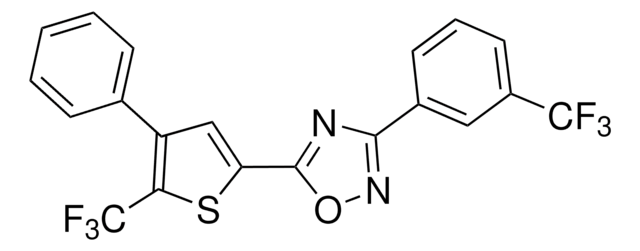Key Documents
S9666
Sphingosine 1-phosphate
≥95% (TLC), powder, lipid second messenger
Synonim(y):
(2S,3R,4E)-2-Amino-4-octadecene-1,3-diol 1-phosphate, D-erythro-Sphingosine 1-phosphate
About This Item
Polecane produkty
product name
Sphingosine 1-phosphate, ≥95%, powder
Poziom jakości
Próba
≥95%
Postać
powder
temp. przechowywania
−20°C
ciąg SMILES
CCCCCCCCCCCCC\C=C\[C@@H](O)[C@@H](N)COP(O)(O)=O
InChI
1S/C18H38NO5P/c1-2-3-4-5-6-7-8-9-10-11-12-13-14-15-18(20)17(19)16-24-25(21,22)23/h14-15,17-18,20H,2-13,16,19H2,1H3,(H2,21,22,23)/b15-14+/t17-,18+/m0/s1
Klucz InChI
DUYSYHSSBDVJSM-KRWOKUGFSA-N
informacje o genach
human ... S1PR1(1901) , S1PR2(9294) , S1PR3(1903) , S1PR4(8698) , S1PR5(53637)
Szukasz podobnych produktów? Odwiedź Przewodnik dotyczący porównywania produktów
Powiązane kategorie
Działania biochem./fizjol.
Cechy i korzyści
Kod klasy składowania
11 - Combustible Solids
Klasa zagrożenia wodnego (WGK)
WGK 3
Temperatura zapłonu (°F)
Not applicable
Temperatura zapłonu (°C)
Not applicable
Środki ochrony indywidualnej
dust mask type N95 (US), Eyeshields, Gloves
Certyfikaty analizy (CoA)
Poszukaj Certyfikaty analizy (CoA), wpisując numer partii/serii produktów. Numery serii i partii można znaleźć na etykiecie produktu po słowach „seria” lub „partia”.
Masz już ten produkt?
Dokumenty związane z niedawno zakupionymi produktami zostały zamieszczone w Bibliotece dokumentów.
Klienci oglądali również te produkty
Nasz zespół naukowców ma doświadczenie we wszystkich obszarach badań, w tym w naukach przyrodniczych, materiałoznawstwie, syntezie chemicznej, chromatografii, analityce i wielu innych dziedzinach.
Skontaktuj się z zespołem ds. pomocy technicznej













